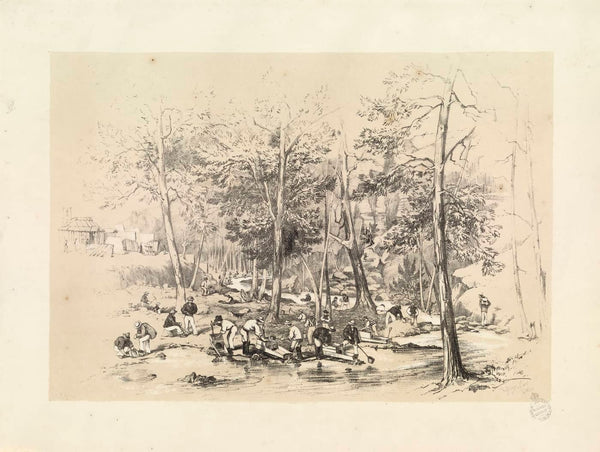

If the pastoral industry was Australia’s first born, then Gold was its second born.
People tend to associate 'The Gold Rush' with California and the Klondike, but as a matter of fact the Australian gold rush remains the world's richest.
The presence of gold within Australia was known for many years prior to what is generally accepted to have been the onset of the Gold rush in 1851.
Spanning between 1851 and 1880, the New South Wales gold rush was Australia’s first, and whose origins centre around a claim shrouded in contention. The title of first discovery of ‘payable gold’ went to Edward Hargreaves. A distinction that carried with it a hefty reward and notoriety.
Whilst many letter writers wrote the claims off as a hollow victory.
On 12 February 1851, Edward Hargraves and his guide, John Lister, set out on horseback with a pan and rocking-cradle, to Lewis Ponds Creek, a tributary of the Macquarie River close to Bathurst, making their famed discovery, at a location Hargreaves would later name Ophir, recalling the moment, sharing that "once in the creek bed he somehow felt surrounded by gold".
(Taylor, 2003)

Edward Hargraves, gold rush publicist, ca. 1880-1884 photographer Henry King
THE GOLD MEDAL; WHO WAS FIRST?
In addition to the Fish River find, there were many other reported findings before word got out to the rest of the world in 1851.It was known by a select few that Gold was also found at:
- Strathloddon, Victoria in 1840
- Hartley, New South Wales in 1844
- Montecute, South Australia in 1846
- Glenmona Station, Victoria (near Maryborough) in 1849
A convict who found gold near Bathurst in 1823 was given 150 lashes with a whip as it was believed he must have stolen it.
Dark Orbit - Eco-Friendly Athletic Hoodie

Paweł Edmund Strzelecki c1845
State Library of New South Wales, Public domain, via Wikimedia Commons
Famed Polish explorer Count Paul Strzelecki is also posited to have found gold in the Australian Alps in 1839, but kept it secret at the behest of the governor.
When Strzelecki published his book, „Physical Description of New South Wales and Van Diemen's Land,” in 1845, he omitted all reference to gold in accordance with the promise which he had given to the Governor. But his claim to priority in discovery is substantiated by two independent pieces of testimony. First, an enclosure accompanying a despatch from Sir George Gipps in 1839 included amongst the minerals, found in New South Wales: „Gold, an auriferous sulphate of iron, partly decomposed, yielding a very small quantity or proportion of sold, sufficient to attest its presence”. Secondly, in a debate in the Legislative Council of New South Wales in 1853, on a proposal to award a gratuity to Edward Hargreaves on account of his discovery of gold at Bathurst, James McArthur said that, to his knowledge Strzelecki in 1839 had exhibited specimens of gold to different gentlemen in Sydney, and “repeatedly told me in private conversation that an extensive goldfield existed in the Bathurst district ”. (STRZELECKI FOUND GOLD BUT KEPT 1939, July 8)

Edward Hammond Hargraves - Angas, George French, 1822-1886, Public domain, via Wikimedia Commons
@kieran.wicks #question from @kieran.wicks #conjecture #Propaganda #Charlatan #Didyouknow #historian #Secret #AustralianHistory #GoldRushStories #OneTownataTime #historyofmoney #GoldFever #LivingArtLifestyle #Strezlecki #GoldMedal ♬ original sound - Kieran.Wicks



STRZELECKI FOUND GOLD BUT KEPT (1939, July 8). The Courier-Mail (Brisbane, Qld. : 1933 - 1954), p. 7. Retrieved July 20, 2021, from http://nla.gov.au/nla.news-article40858032
More on Strzelecki finds https://www.kidsnews.com.au/gold-rush/the-big-secret-gold-was-discovered-long-before-the-gold-rush/news-story/84b4aff7a7e66ed1d7bc3646705bf200

Edward Hammond Hargraves - Angas, George French, 1822-1886, Public domain, via Wikimedia Commons

Mr E.H. Hargraves, the gold discoverer of Australia, Feb 12th 1851, returning the salute of the gold miners, 1851, by T.T. Balcombe, oil on canvas, State Library of New South Wales
Sketch Of The GOLD DIGGINGS AT OPHIR By Samuel Sidney From The Book The Three Colonies Of Australia - Samuel Sidney, Public domain, via Wikimedia Commons

Panning for gold - Ophir, NSW c 1888 - Photographed by James Mills (SLNSW)

Map of Ophir 1851
Plan of the town of Ophir, situate on Lewis Ponds, Co. of Bathurst, the property of H. Perrier, Esq. [cartographic material] to be sold by auction by Messrs Mort & Brown on Friday 1st August 1851 / [William Meadows Brownrigg] - "N.B. The allotments vary in size from one to two acres"
Cadastral map showing roads and lots for auction. Street and other borders: Grafton Street, Lewis Ponds, Holden Street and Albert Street.
Star Tracer - Eco-Friendly Athletic Hoodie

Book Cover
Sketches in Australia plates from G. F. Angas - six views of the gold field of Ophir 1851

Contents Page

Gold Washing at Summer Hill

Encampment of Diggers

Fitz Roy Bar, at the Junction of the two Creeks

A General View of Ophir

Gold Diggers Arrive at Bathurst on their way to Ophir

Summerhill Creek and part of Church Hill in the distance
Dark Hydra - Unisex Heavy Cotton Tee



























